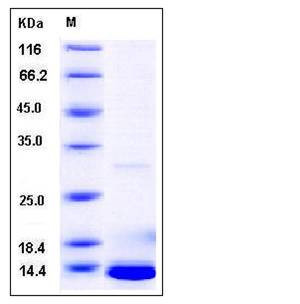Human S100A5 Protein (His Tag)
S100D
- 100ug (NPP4234) Please inquiry
| Catalog Number | P11142-H07E |
|---|---|
| Organism Species | Human |
| Host | E. coli |
| Synonyms | S100D |
| Molecular Weight | The recombinant human S100A5 consisting of 120 amino acids and has a calculated molecular mass of 14.2 kDa. It migrates as an approximately 14 kDa band in SDS-PAGE under reducing conditions. |
| predicted N | Met |
| SDS-PAGE |  |
| Purity | > 92 % as determined by SDS-PAGE |
| Protein Construction | A DNA sequence encoding the human S100A5 (B48219) (Met 1-Lys 110) was expressed, with a polyhistide tag at the N-terminus. |
| Bio-activity | |
| Research Area | Cancer |Signal transduction |Signaling Pathway |Calcium Signaling |Calcium Binding Proteins |
| Formulation | Lyophilized from sterile 20mM Tris, 10% glycerol, pH 8.0 1. Normally 5 % - 8 % trehalose, mannitol and 0.01% Tween80 are added as protectants before lyophilization. Specific concentrations are included in the hardcopy of COA. |
| Background | S100 protein?is a family of low molecular weight protein found in vertebrates characterized by two?EF-hand calcium-binding motifs. There are at least 21 different S100 proteins, and the name is derived from the fact that the protein is?100%?soluble in ammonium sulfate?at neutral?pH. Most S100 proteins are disulfide-linked homodimer, and is normally present in cells derived from the?neural crest, chondrocytes, macrophages, dendritic cells, etc. S100 proteins have been implicated in a variety of intracellular and extracellular functions. They are involved in regulation of protein phosphorylation, transcription factors, the dynamics of cytoskeleton constituents, enzyme activities, cell growth and differentiation, and the inflammatory response.?? Protein S100-A5, also known as Protein S-100D, S100 calcium-binding protein A5, S100A5 and S100D, is a member of the S100 family which contains two?EF-hand domains. S100A5 is also a novel member of the EF-hand superfamily of calcium-binding proteins that is poorly characterized at the protein level. It is expressed in very restricted regions of the adult brain. From birth onwards, S100A5 remained a neuronal-specific protein, only located in a subpopulation of neurons in the spiral ganglion. |
| Reference |
